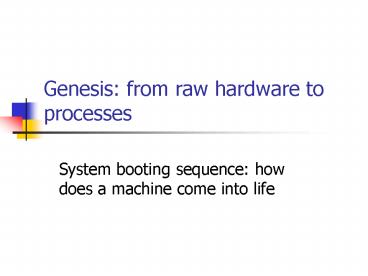Genesis: from raw hardware to processes - PowerPoint PPT Presentation
Title:
Genesis: from raw hardware to processes
Description:
BIOS loads a more sophisticated loader from the boot sector and yields control to it. ... A user can specify which disk partition and OS image to boot ... – PowerPoint PPT presentation
Number of Views:18
Avg rating:3.0/5.0
Title: Genesis: from raw hardware to processes
1
Genesis from raw hardware to processes
- System booting sequence how does a machine come
into life
2
How is the First Process Created?
- What happens when you turn on a computer?
- How to get from raw hardware to the first running
process, or process 1 under UNIX?
3
Booting Sequence
- The address of the first instruction is fixed
- It is stored in read-only-memory (ROM)
- ROM is read-only, permanent memory, and is always
available to be used.
4
Booting Procedure for i386 Machines
- On i386 machines, ROM stores a Basic Input/Output
System (BIOS) - BIOS contains program that knows how to access
storage devices, keyboard, and graphic card.
5
BIOS Code
- Performs Power-On Self Test (POST)
- Tests the system
- Looks for and checks peripherals
- During this time, you will hear memory counting,
which consists of noises from the floppy and hard
drive, followed by a final beep - Locates a valid device with which to boot the
system (boot device) - Floppy ? CDROM ? hard drives
6
After the POST
- The master boot record (MBR) is loaded by BIOS
from the boot device. - The MBR is stored at the first logical sector
(track 0, cylinder 0, and head 0) of the boot
device (e.g., a hard drive) that - Fits into a single 512-byte disk sector (boot
sector) - Boot loader machine code instructions for
booting the machine. - Partition table the physical layout of the disk
(e.g., number of tracks)
7
After Getting the Info on the Boot Device
- BIOS loads a more sophisticated loader from the
boot sector and yields control to it. - Under Linux, this sophisticated loader is called
LILO (Linux Loader) or Grub (GNU Grub Unified
Boot Loader). - The more sophisticated loader loads the operating
system
8
More on OS Loaders
- LILO
- Is partly stored in MBR with the disk partition
table. - A small machine code binary on the MBR whose job
is to locate the second stage boot loader and
load the first part of it into memory. - A user can specify which disk partition and OS
image to boot - Every time a configuration change is made, run
/sbin/lilo to change MBR. - Windows loader assumes only one bootable disk
partition - After loading the kernel image, LILO sets the
kernel mode and jumps to the entry point of the
operating system
9
Booting Sequence in Brief
- A CPU jumps to a fixed address in ROM,
- Loads the BIOS,
- Performs POST,
- Loads MBR from the boot device,
- Loads an OS loader,
- Loads the kernel image,
- Sets the kernel mode, and
- Jumps to the OS entry point.
10
Linux Initialization
- Set up a number of things
- Trap table
- Interrupt handlers
- Scheduler
- Clock
- Kernel modules
- Process manager
- Hand-craft environment for the init process (the
first process, process 1).
11
Process 1
- Is instantiated from the init program
- Is the ancestor of all processes
- Controls transitions between runlevels
- Executes startup and shutdown scripts for each
runlevel
12
- On RedHat, the init do the following (run as a
process) - Run /etc/rc.d/rc.sysinit that sets environment
path, checks file system, etc (system
initialization) - Run /etc/inittab script that decides how system
should be setup in each runlevel. - Set the source function library,
/etc/rc.d/init.d, how to start and kill a
program, etc - Start all background processes by looking at the
rc directories for the runlevel as default in
/etc/inittab e.g /etc/rc.d/rc5.d for runlevel 5.
- Fork /sbin/mingetty to give virtual consoles
(login prompts).
13
Runlevels
- Level 0 shutdown
- Level 1 single-user
- Level 2 multi-user (without network file
system) - Level 3 full multi-user
- Level 5 X11
- Level 6 reboot

